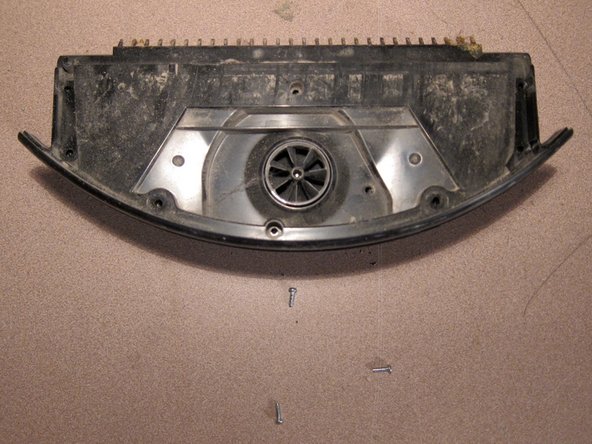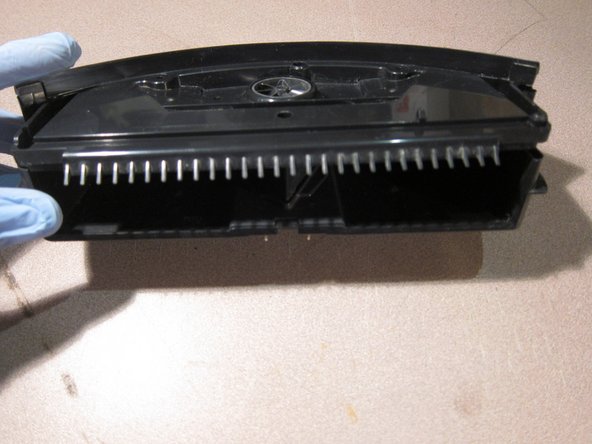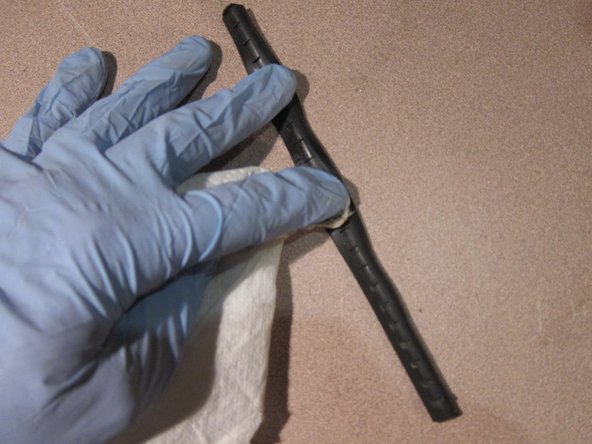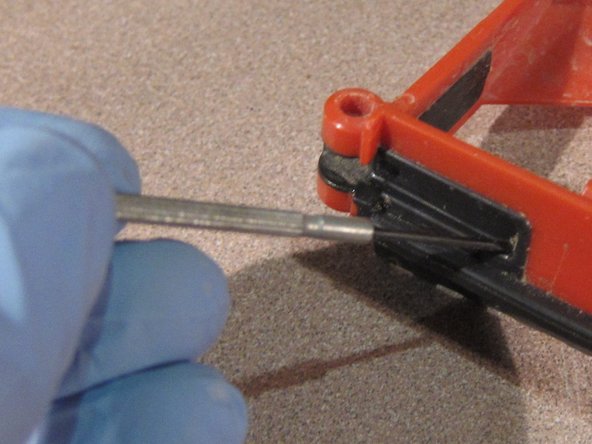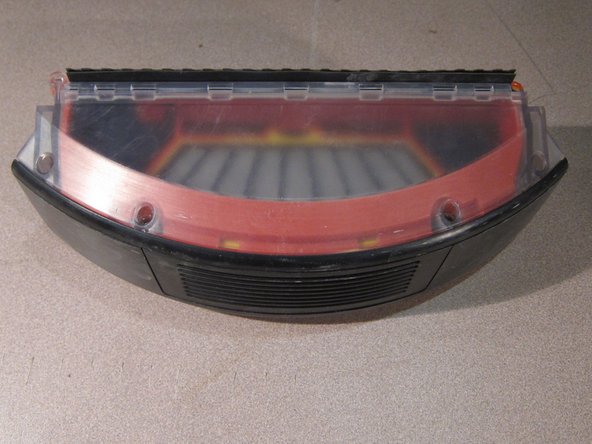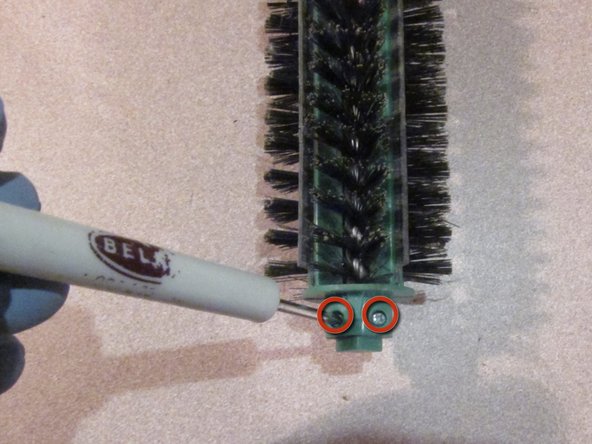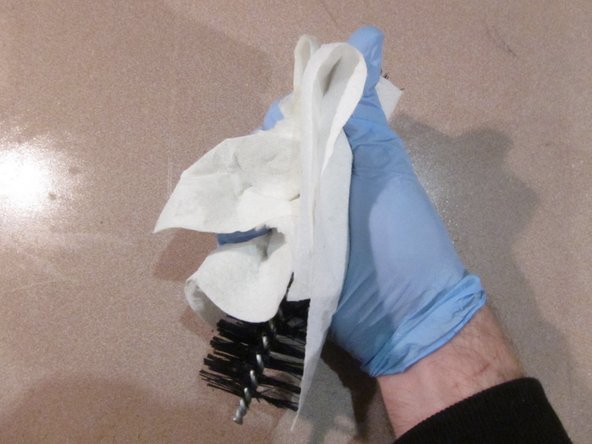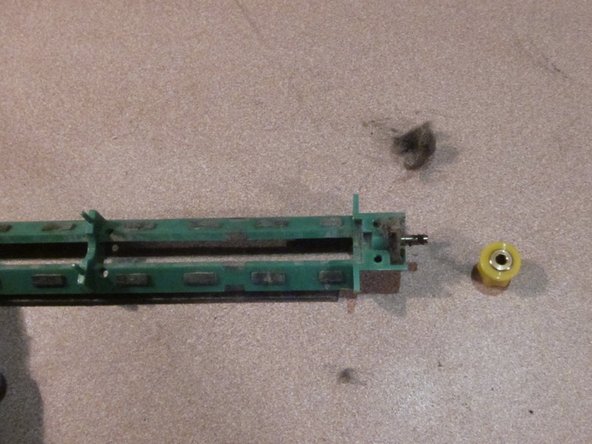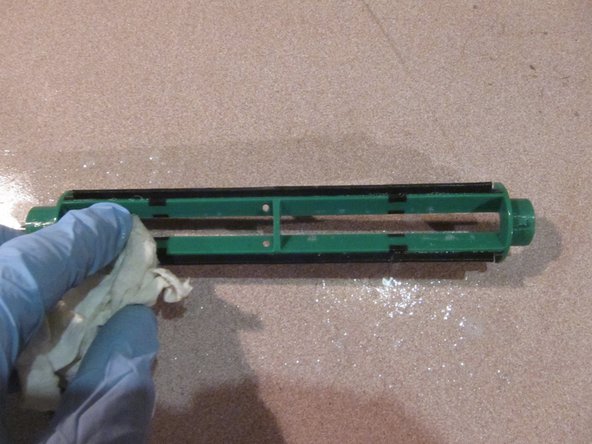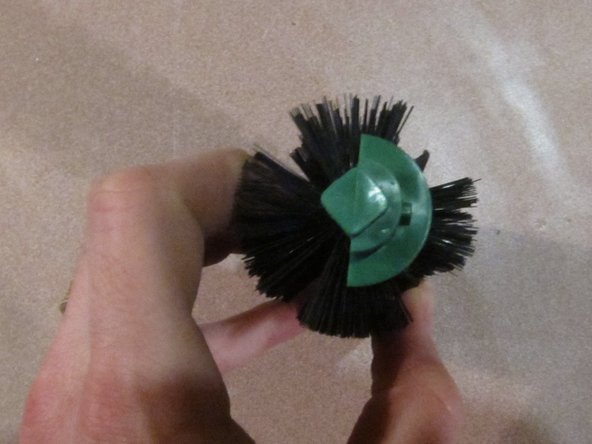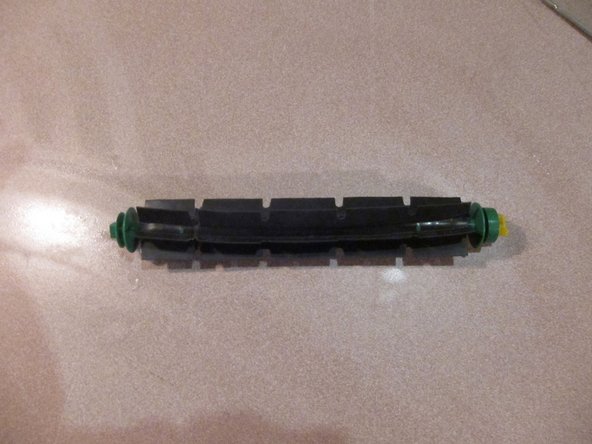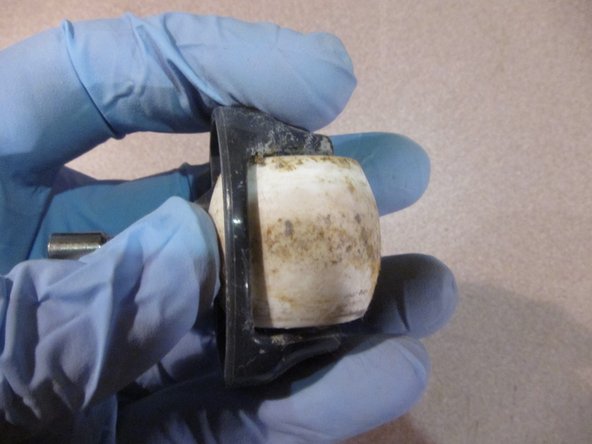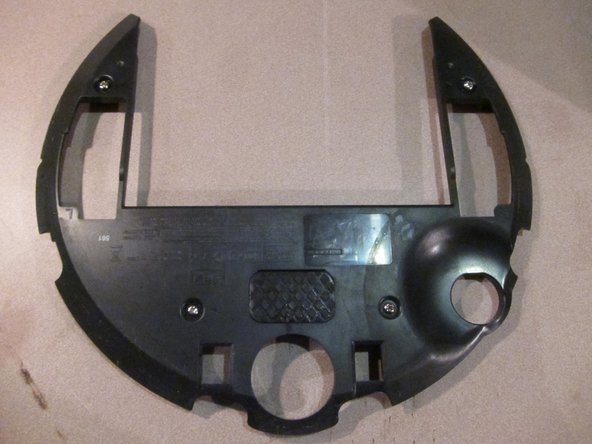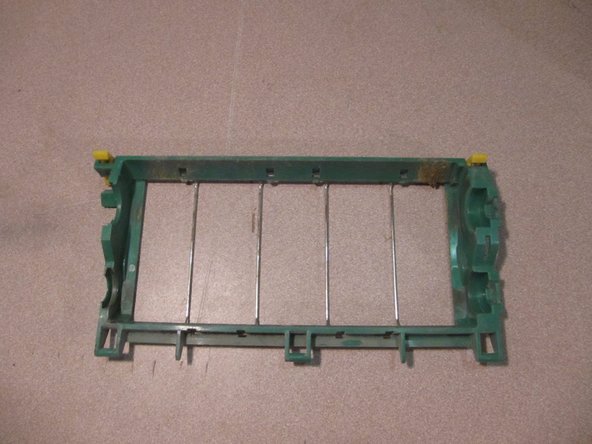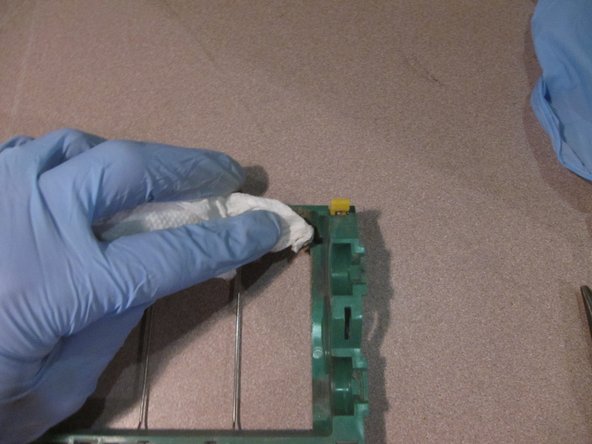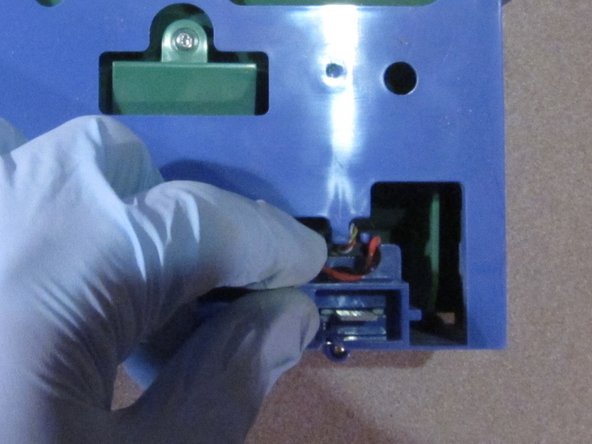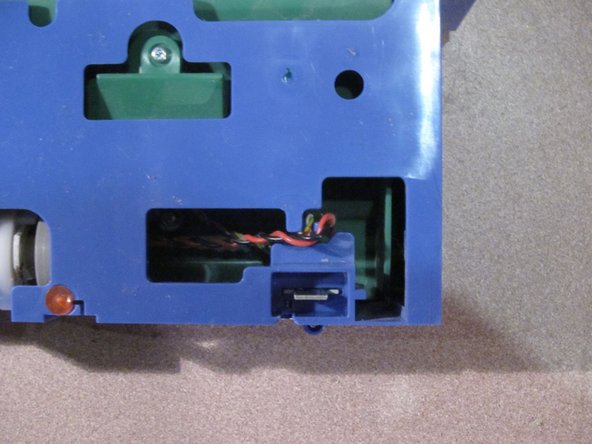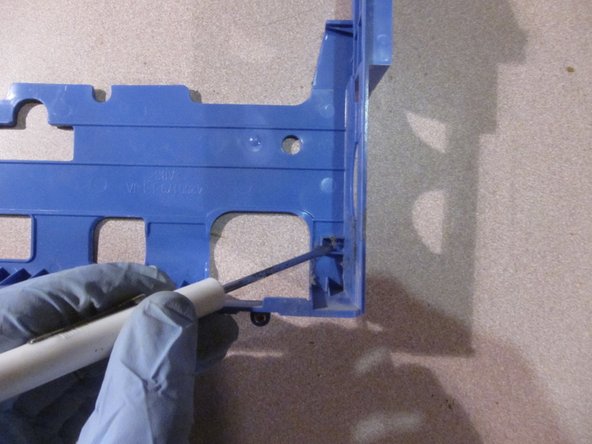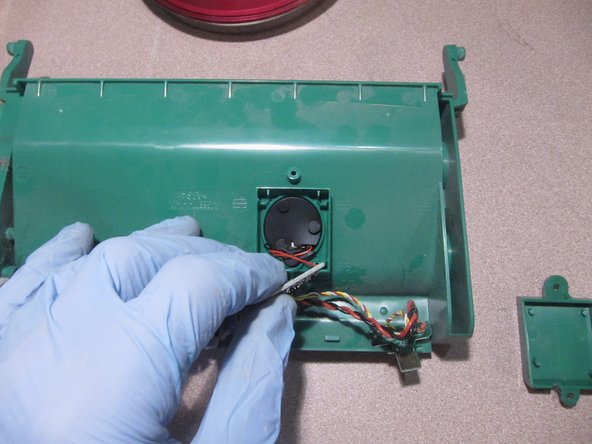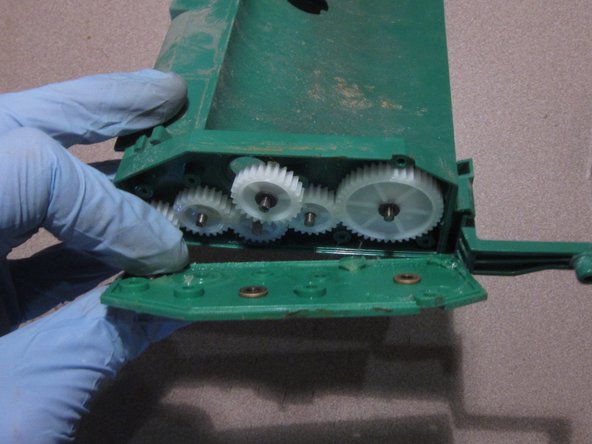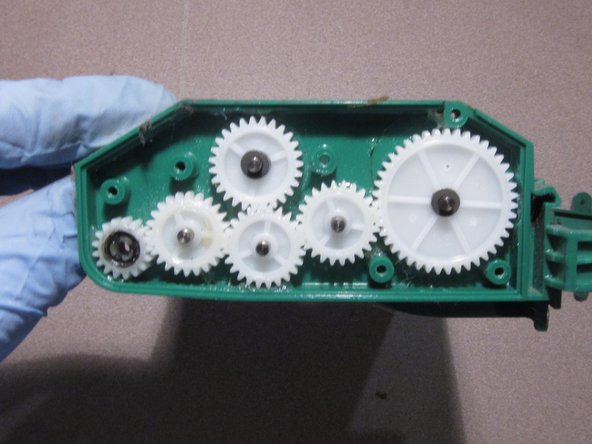Questa versione può contenere modifiche errate. Passa all'ultima istantanea verificata.
Cosa ti serve
-
Questo passaggio è privo di traduzione. Aiuta a tradurlo
-
Remove dust bin from Roomba. This will be the first sub-assembly cleaned.
-
-
Questo passaggio è privo di traduzione. Aiuta a tradurlo
-
Open red dust-bin cover. Remove debris from the dust-bin.
-
Remove the filter from the red dust-bin cover.
-
Remove the red dust-bin cover from the bin by gently pressing on the red cover near the hinge.
-
-
Questo passaggio è privo di traduzione. Aiuta a tradurlo
-
Turn over the dust-bin.
-
Remove 6 screws from the clear bottom dust-bin cover.
-
Remove the clear bottom dust-bin cover.
-
-
Questo passaggio è privo di traduzione. Aiuta a tradurlo
-
Remove three screws from the remaining dust-bin assembly.
-
Lift to remove middle plate from dust-bin assembly.
-
Slide out and remove exhaust grill from dust-bin assembly.
-
-
Questo passaggio è privo di traduzione. Aiuta a tradurlo
-
Turn over top dust-bin plate so the release button is facing up.
-
Remove screw from top plate.
-
Remove blower assembly, push-button, and spring.
-
-
Questo passaggio è privo di traduzione. Aiuta a tradurlo
-
Remove two screws from blower assembly.
-
Clean dirt and debris from top of blower assembly.
-
Carefully lift top from blower assembly. DO NOT DETACH WIRES.
-
Clean underside of blower cover and around blower.
-
Replace blower cover with two screws.
-
-
Questo passaggio è privo di traduzione. Aiuta a tradurlo
-
Turn over blower assembly
-
Clean underside surface of blower assembly.
-
Clean fan blades using a cotton swab.
-
Turn blower assembly on its side.
-
Again, clean fan blades using a cotton swab.
-
-
Questo passaggio è privo di traduzione. Aiuta a tradurlo
-
Clean all surfaces of the top plate of the dust bin.
-
-
Questo passaggio è privo di traduzione. Aiuta a tradurlo
-
Clean all sides of vent grill and between grill slats.
-
-
Questo passaggio è privo di traduzione. Aiuta a tradurlo
-
Clean all surface of the middle plate of the dust bin.
-
Clean between the teeth on the front edge of the plate.
-
-
Questo passaggio è privo di traduzione. Aiuta a tradurlo
-
Re-assemble the blower assembly, vent grill, button, button spring, and top & middle dust-bin plates.
-
Make sure blower assembly slides into the two channels.
-
Replace 3 screws on middle plate and 1 screw on top plate.
-
-
Questo passaggio è privo di traduzione. Aiuta a tradurlo
-
Clean all surfaces of the clear dust bin cover.
-
Pull off the rubber strip and clean under the rubber strip.
-
Clean all surfaces of the rubber strip.
-
Re-install rubber strip.
-
-
Questo passaggio è privo di traduzione. Aiuta a tradurlo
-
Clean all surfaces of the red dust-bin cover.
-
Use a small flathead screwdriver or pick to clean inside corners.
-
Replace filter with new filter for best results.
-
-
-
Questo passaggio è privo di traduzione. Aiuta a tradurlo
-
Re-attach clear dust-bin cover to dust-bin assembly (see step 11) with six screws.
-
Insert red dust-bin cover.
-
Set clean dust-bin aside.
-
-
Questo passaggio è privo di traduzione. Aiuta a tradurlo
-
Turn Roomba upside-down so the brushes are facing up.
-
Open brush cage by pressing on yellow tabs and pulling up on the green brush cage lid.
-
Remove both brushes, lifting from the right side of the brushes.
-
-
Questo passaggio è privo di traduzione. Aiuta a tradurlo
-
Remove the two yellow endcaps from the bristle brush.
-
Run the brush through the red bristle cleaning tool, included with your Roomba.
-
Repeat several times until the the cleaning tool no longer picks up hair/fibers.
-
-
Questo passaggio è privo di traduzione. Aiuta a tradurlo
-
Clip the zip-tie with a pair of snips and remove the zip-tie from the brush.
-
Remove four screws from the ends of the brush.
-
Pull apart green brush housing.
-
-
Questo passaggio è privo di traduzione. Aiuta a tradurlo
-
Spray bristles with an all-purpose cleaning solution.
-
Squeeze bristle rod with a paper towel and run bristle rod through paper towel.
-
Repeat several times until bristles are clean.
-
-
Questo passaggio è privo di traduzione. Aiuta a tradurlo
-
Remove yellow bearing from green bristle housing.
-
Clean yellow bearing and hair/fibers from the axle.
-
Clean all surfaces of both parts of the green bristle brush housing.
-
-
Questo passaggio è privo di traduzione. Aiuta a tradurlo
-
To re-assemble the green brush housing, push the green housing against the side of one row of bristles.
-
Push on the bristles until they no longer fan out and the bristle tips are lined up with the long slot in the green brush housing.
-
Rotate the green brush housing so the line of bristles goes through the slot in the green brush housing.
-
Repeat step for the other green brush housing.
-
-
Questo passaggio è privo di traduzione. Aiuta a tradurlo
-
Replace 4 screws on the ends of the brush.
-
Run the zip-tie through holes near the center of the brush. Secure the zip tie and clip of any excess.
-
Re-attach yellow bearing and two yellow endcaps.
-
Set aside for later installation.
-
-
Questo passaggio è privo di traduzione. Aiuta a tradurlo
-
Remove plastic sweeper bar from brush housing.
-
Remove yellow plastic end-piece from axle.
-
Remove hair and debris from both ends of axle. You may need to use a small pick or manicuring scissors to remove hair from the axle.
-
-
Questo passaggio è privo di traduzione. Aiuta a tradurlo
-
Spray all surfaces with cleaning solution. Wipe clean with paper towel. Follow up with smaller cleaning tools if necessary.
-
Clean yellow plastic end piece with cleaning solution and paper towel or cotton swab.
-
Replace yellow plastic end piece on axle.
-
Set aside for later installation.
-
-
Questo passaggio è privo di traduzione. Aiuta a tradurlo
-
With Roomba wheels-up, grab onto front wheel and firmly pull straight up to remove wheel.
-
From the underside of the wheel housing, push the wheel out of the housing.
-
-
Questo passaggio è privo di traduzione. Aiuta a tradurlo
-
Remove the axle from the wheel.
-
Thoroughly clean the axle and the wheel with a paper towel and cleaning solution.
-
Thoroughly clean wheel housing with paper towel, cotton swab, and cleaning solution.
-
Re-assemble wheel housing by inserting axle in wheel and pressing wheel with axle back into wheel housing.
-
DO NOT insert wheel housing back into Roomba body. That will be done later.
-
-
Questo passaggio è privo di traduzione. Aiuta a tradurlo
-
Remove center screw from edge brush and set aside.
-
Remove brush from Roomba body by lifting on any set of bristles.
-
-
Questo passaggio è privo di traduzione. Aiuta a tradurlo
-
Place edge brush on paper towel and douse with cleaning solution.
-
Rub each set of bristles with paper towel until bristles appear clean and free of debris.
-
Place edge brush on a clean paper towel and douse with bleach water.
-
Rub each set of bristles with paper towel as you did earlier with the cleaning solution.
-
Set aside for later assembly.
-
-
Questo passaggio è privo di traduzione. Aiuta a tradurlo
-
Unscrew 4 screws from the underside of the Roomba. Screws will separate from underside plastic plate.
-
Spray with cleaning solution and clean with paper towel. Follow up with smaller cleaning tools if needed.
-
Set aside for later installation.
-
-
Questo passaggio è privo di traduzione. Aiuta a tradurlo
-
Unscrew 4 screws around the brush cage housing. Screws will not separate from brush cage housing.
-
Lift brush cage assembly from Roomba body.
-
-
Questo passaggio è privo di traduzione. Aiuta a tradurlo
-
Place the brush assembly with the blue housing facing down.
-
Open the cage lid
-
Remove the brush cage lid by firmly pulling up at the hinges. Remove one hinge at a time.
-
Clean all surfaces of the brush cage with cleaning solution, paper towels, and cotton swabs. You may need to use a pick to clean tight corners and slots.
-
-
Questo passaggio è privo di traduzione. Aiuta a tradurlo
-
Place brush cage housing upside down (blue part up).
-
Remove screw securing daughtercard.
-
Move black and red wires inside the blue housing. This is required when separating the green brush cage assembly from the blue housing.
-
-
Questo passaggio è privo di traduzione. Aiuta a tradurlo
-
Remove red sticker. This is holding down a small, round, weight attached to a cable.
-
Pull the cable through the channel. This cable limits travel of the blue housing.
-
-
Questo passaggio è privo di traduzione. Aiuta a tradurlo
-
Flip the brush cage assembly over. Arrange so the two "arms" are facing you.
-
On one side, pull apart the green cage arm from the blue housing arm and lift out.
-
Repeat on the other arm. The green brush cage assembly will lift out of the blue housing.
-
-
Questo passaggio è privo di traduzione. Aiuta a tradurlo
-
Clean all surfaces of the blue housing with cleaning solution, paper towels, and cotton swabs. Use a pick to clean the debris out of tight spaces.
-
-
Questo passaggio è privo di traduzione. Aiuta a tradurlo
-
Place green brush cage upside down.
-
Remove 2 screws securing the square sensor cover. Set sensor cover aside.
-
Remove daughtercard from daughtercard mount.
-
-
Questo passaggio è privo di traduzione. Aiuta a tradurlo
-
Flip the green brush cage over.
-
Remove the sensor by gently pressing on the silver disc.
-
-
Questo passaggio è privo di traduzione. Aiuta a tradurlo
-
Turn green brush cage over so the motor is facing up.
-
Remove 2 screws securing the grey motor support to the green brush cage.
-
Pull the motor sideways out of the gearbox.
-
Remove the foam bushing and set aside.
-
-
Questo passaggio è privo di traduzione. Aiuta a tradurlo
-
Remove 6 screws from the gear housing.
-
Pull front cover away from the brush cage body.
-
-
Questo passaggio è privo di traduzione. Aiuta a tradurlo
-
Clean all surfaces of the green housing with cleaning solution, paper towels, and cotton swabs. Use a pick to clean the debris out of tight spaces.
-
Annulla: non ho completato questa guida.
Altre 27 persone hanno completato questa guida.
4 Commenti
Just need to do that every few months and mine will probably last another year. I love the idea of the Roomba but the execution of the idea is worse than ...%#*@ I can't think of a poorer design built from as great an idea.
Thanks to the author for putting together such a complete guide to the most maintenance-heavy cleaning-maintenance device of all time.
Thanks.
I will add the companion guide for lazy people.
Step 1. Fire up your air compressor and attach a blower nozzle.
Step 2. Take the Roomba outside. Blow into everything you can. Dust will come out.
Step 3. Clip the wound-up hair out of the brushes, blow 'em clean again.
That's it. If you've got compressed air, maintaining a Roomba is simple. You could also just use that canned-air duster thing you have sitting next to your computer keyboard.
As far as problems go, only two problems ever seem to occur in real life. The battery is obviously one. The other is a failure somewhere in the cleaning head gear train. This is solved by simply replacing the cleaning head, a five-minute repair requiring a part you can buy on eBay for $50. Now you don't have to worry about taking the cleaning head apart and refurbishing it, because you're lazy and have money. Go ahead, do it the easy way. Get a new cleaning head, blow some compressed air through it while you have it apart, and your bot will be good as new.
I've had my roomba at least 5 years and I've had to fix the bump sensor twice. There is an LED deep in the guts of your roomba that gradually dims, and when it goes you get roomba going in circles and beeping nine times. You can fix it but it requires some crazy disassembly and some soldering. See here for a guide: http://www.schneordesign.com/Avi/irobot/...
I have some extra LEDs from the last time I did this.
An alternative is to replace a surface-mount component on the main circuit board with a different value to accommodate the dimming LED in the sensor. This modification was posted in I think 2011 by a USA uni prof - I forget who. The left bump sensor relevant component to be replaced is R87, a 20k resistor (marked 203 in sm value coding). For the right bump sensor it is R82 again a 20k resistor of course. In each case the component to be removed and replaced is sited adjacent and parallel to a 1k resistor (sm marking 102), R86 and R83 respectively. He suggested using 130k resistors as replacement components, I used 220k to get a few more years out of my ageing Roomba 530. 1/8th watt conventional resistors fit reasonably well in place of the sm devices. It seems the section of the main circuit board containing the parts to be replaced is common to many of the model numbers, including component IDs and layout even when other parts of the board differ to the extent of including extra switches for some models.






